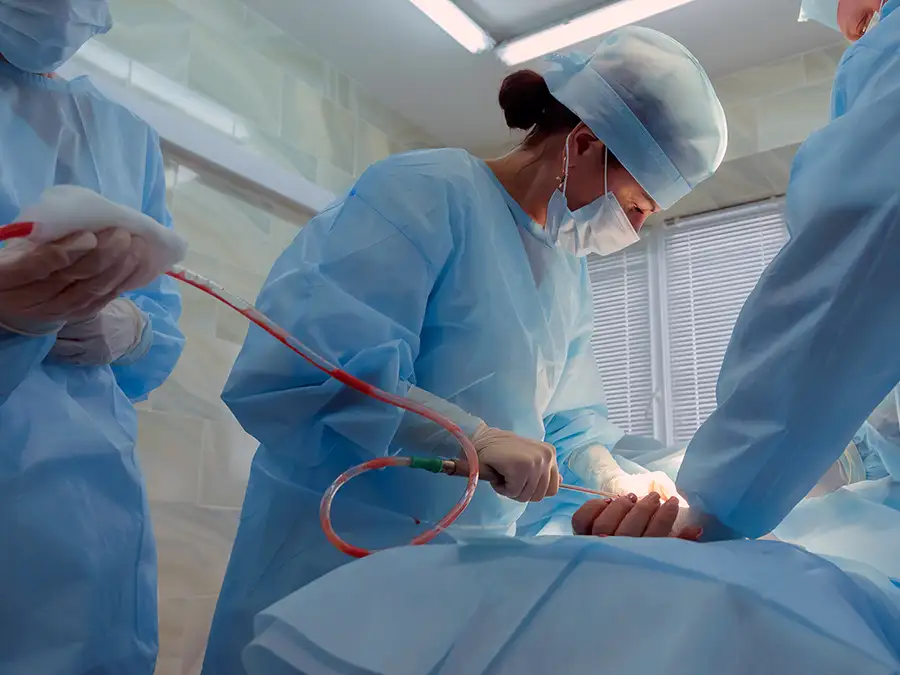
Learn about your legal options after a wrong-site surgery in Florida
Wrong-site surgeries have become a growing concern in recent years. These preventable mistakes can have devastating impacts on patients, leading to unnecessary pain, suffering and long-term health complications.
In this article, we’ll explore the dangers of wrong-site surgery errors, their causes, and the legal options available to victims seeking justice for these negligent acts.
What is a wrong-site surgery?
A surgeon performs a wrong-site surgery when they perform a surgical procedure on the wrong area of the body, including:
- The wrong side of the body
- The wrong organ or the wrong part of an organ
- The wrong limb
Frequency of wrong-site surgeries
Wrong-site surgeries are relatively rare. Studies show that they occur in 1 out of every 112,000 operating room surgical procedures. Of these, 60% occur on the wrong side of the body.
Common causes of wrong-site surgeries
In 2014, a group of 8 hospitals formed the Joint Commission for Transforming Healthcare to conduct a wrong-site surgery project. The project found that wrong-site surgeries stemmed from 4 stages of the surgical process. They are:
- Scheduling
- Pre-op and holding
- Operating room
- Organizational culture
Scheduling
Several aspects of the scheduling stage of the surgery process were found to raise the risk of wrong-site surgeries. Failures at that stage included the following:
- Schedulers failed to verify the presence and accuracy of booking documents.
- Schedulers accepted verbal requests for bookings rather than written documents.
- Booking forms contained unapproved abbreviations, cross-outs and illegible handwriting that were misconstrued.
Pre-op and holding
The pre-op stage of the surgery process falls between the scheduling stage and the operating room. Mistakes there that led to wrong-site surgeries included the following:
- Primary documents were missing, inconsistent or incorrect.
- Surgical site marking was defective (e.g., inconsistent or made with an unapproved marker).
- The pre-op team failed to adequately verify the patient.
Operating room
Distractions and fatigue during surgical procedures often led to mistakes in the operating room, including:
- The surgical team failed to establish site verification between multiple procedures performed by the same provider.
- There was poor communication when procedures were handed off.
- The surgical team failed to consult primary documents to verify patient identity, procedure, site and side prior to the procedure.
- Site marks were accidentally removed during operating room prep.
- Frequent distractions occurred during time-outs.
- Time-outs were held without the full participation of team members.
Organizational culture
Organizational culture defects that led to wrong-site surgeries as well as other harmful mistakes included the following:
- Inconsistent attention to patient safety.
- Cultural intimidation that prevented staff from speaking up.
- Inadequate staff education on policy changes.
Missouri surgeon performs 2 wrong-site surgeries on the same patient
A woman in Franklin County, Missouri, was the victim of 2 wrong-site surgeries by the same surgeon. The surgeon operated on the wrong part of her spine on 2 separate occasions, removing portions of her spine that didn’t need to be removed.
The woman sued the doctor and the hospital. The jury awarded her $1 million, but it was reduced to $450,000 because of a state law cap. The patient has so far not received a penny of her jury award while she continues to suffer pain and incur expenses for healthcare and medications.
What is the Universal Protocol?
After these issues were discovered, the Joint Commission developed guidelines called the Universal Protocol in an attempt to reduce wrong-site surgery errors. In part, it established the following standards:
- A time-out must be conducted immediately before starting the surgery.
- The time-out must be standardized.
- The time-out participants must include the individual performing the procedure, the anesthesia providers, the circulating nurse, the operating room technician, and other active participants.
- During the time-out, the participants must agree on the correct identity of the patient, the correct site, and the procedure.
- The time-out proceedings must be documented.
Since it was first implemented, the Universal Protocol has been shown to improve teamwork and reduce the risk of wrong-site surgery by the following:
- 46% in the scheduling phase
- 63% in the pre-op/holding phase
- 51% in the operating room
Consequences of wrong-site surgeries
A serious consequence of a wrong-site surgery is that the actual reason for the surgery is not achieved. This means that the condition goes untreated, and pain and suffering, if that was the reason for surgery, continue.
Furthermore, correction of the mistake often requires two more surgical procedures: one to reverse the mistake and one to address the initial reason for the surgery. As a result, the patient must endure longer recovery periods, possibly permanent disabilities, more pain and suffering, and additional medical costs.
The patient typically experiences employment disruptions and lost wages, and their future employment possibilities might also be impaired.
All of these potential consequences can be grounds for a medical malpractice claim. Failure to follow the Universal Protocol is usually pointed to as the defendant’s failure to meet the standard duty of care owed to the plaintiff.
Brazilian butt lift surgery: Troubled reliability behind enhanced beauty
Beneath the veneer of beauty lies a distressing truth—a surge in fatalities linked to butt lift procedures, despite efforts to curb the risks.
What is medical malpractice?
Medical malpractice cases, like other personal injury cases, are governed by precedents, statutes and principles of tort law. A tort is a civil wrong for which the plaintiff (the person harmed) seeks compensation. A “wrong” is an act or omission that harms another person or property.
The plaintiff has the burden to prove liability and damages. Proving liability requires the plaintiff to show that:
- The defendant had a duty of care to the plaintiff;
- The defendant failed to serve that duty; and
- The defendant’s failure was the proximate cause of the harm to the plaintiff.
If it can be proven that a defendant failed in their duty of care, the injured party may be eligible for compensation through a medical malpractice lawsuit.
Who may be liable for a wrong-site surgery?
Surgeries typically involve a team of many healthcare providers, each of whom owes a duty of care to the patient. If there is miscommunication among the team members resulting in the surgeon’s wrong-site surgery, other members might share responsibility.
However, while other team members can share liability if they are negligent, the surgeon or surgeons are ultimately responsible for the proper performance of the surgical procedure.
The hospital might also share in the liability, depending on the relationship between the surgeon and the hospital. In some cases, the surgeon and their team operate as independent contractors who simply “rent” the hospital’s facilities. In other cases, the surgeon and their team are employees under an employment contract with the hospital. In the latter case, the hospital may be liable for the actions of its surgeon employee.
Types of damages in a medical malpractice case
Damages in a personal injury or medical malpractice lawsuit include compensatory and, rarely, punitive damages. Compensatory damages are either economic or non-economic.
Economic damages include:
- Medical expenses
- Lost wages
- Other losses that can be measured by recognized financial loss
Non-economic damages include:
- Pain and suffering
- Mental anguish
- Loss of companionship
- Permanent disfigurement
- Physical impairment
Punitive damages, while rarely imposed, may also be available and are intended to punish the defendant for egregious conduct with monetary penalties to deter the defendant and others from such behavior in the future.
Florida ranks high among the states for medical malpractice lawsuits and awards. In fact, in 2020, Florida had the most medical malpractice claims in the U.S., with a total of 670. The average compensation in these lawsuits fell between $50,000 and $500,000.
Many states have imposed caps on non-economic damages, such as pain and suffering. Other states have imposed limits specifically on medical malpractice claims. Florida was one of those states, but recently, the law was struck down as unconstitutional.
What steps should I take if I’m the victim of medical malpractice in Florida?
If you’re the victim of a wrong-site surgery or any other kind of medical malpractice in Florida, take the following steps:
- Start by writing down every relevant event before, during and after your surgical procedure. It’s best to do this as soon as possible because memories tend to fade over time.
- Your next step is to check the surgeon’s record to see if there are any prior claims against them. If there are none, you might consider talking to the surgeon. Sometimes, an amicable solution can result if you only experience minimal inconvenience or injury.
- You should get a second opinion even if your surgeon proposes a solution.
- If you believe that your surgeon was negligent, you should change doctors immediately and stop communicating with the original surgeon or their associates.
- Finally, you should consult a skilled medical malpractice attorney for an assessment of your case under Florida law.
Get help from an experienced Florida medical malpractice attorney
Medical malpractice cases are complicated. They require an attorney with knowledge of general personal injury law, trial procedure and evidence rules. But they also require more specialized experience with medical malpractice because of the highly technical aspects of medicine.
If you or a loved one has been the victim of a wrong-site surgery in Miami, the experienced medical malpractice attorney Mike Redondo is here to help. Mike has a proven track record of successfully representing those injured through the negligence of others, always placing client satisfaction above all else.
Mike also speaks both Spanish and English and is happy to offer a free, comprehensive evaluation to potential clients. Contact Redondo Law today so we can help you get the compensation and justice you deserve.


